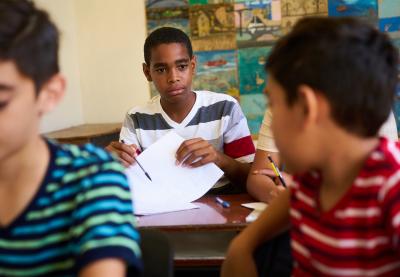Editor’s note: This article is the second in a three-part series that links three important ideas—implicit bias, stereotype threat and identity safety—all backed by research.
Most teachers want to be fair to each student. How many times have you heard educators say, “I treat everyone the same”? But is this even possible—or desirable? When we ignore differences, even in the absence of overt negative stereotypes, implicit bias is still at play—and there is another detrimental force that can flourish under the surface: stereotype threat.
Stereotype threat theory states that people from negatively stereotyped groups may fear being “judged or treated in terms of the stereotype or that [they] might do something that would inadvertently confirm it."[1] In other words, individuals may worry that they’ll in some way confirm that negative stereotype, and this worry has been found to lower performance.[2]
How Does Stereotype Threat Work?
Over 300 studies involving people of all ages who are subject to a range of different stereotypes (e.g., race, ethnicity, gender, age) have consistently shown the power of stereotypes to negatively impact all kinds of performance, depending on the stereotype.
Researchers have found, for example, that awareness of the negative stereotype that black and Latino students are less intelligent than white and Asian students can actually negatively affect performance levels in black and Latino students. In one study, black and white students were given the same test. When the test was described as a game, the students performed equally well. But when it was described as a test of ability, students of color scored lower.
In another study, black students were broken into two groups and given a test. One group was told to write their name and ethnicity on the top of the page. The other group wasn’t. Those who wrote their ethnicity at the top did not perform as well. Similar results occurred in studies when women were asked to identify their sex on math tests and senior citizens were asked to identify their age on memory tests.
As discussed in the first article in this series, breaking down negative stereotypes is one important way to reduce the prejudices that lead to unconscious prejudice and racism. And the same effort will also counter stereotype threat. To tackle negative stereotypes in the classroom and schools, here are some suggestions:
Reflect on Ourselves
It is important that we take time to reflect and ask ourselves difficult questions. How have we inadvertently absorbed some of the negative stereotypes that surround us? Try to notice the stereotypes you see and hear in your daily life from the media and from your personal encounters. Have you heard any in the staff room? A common one is using the phrase “those kids” as a code that separates the speaker from—usually—low-income students or students of a specific identity group, implying that they are a problem.
Address Negative Stereotypes in the Moment
As soon as you hear a negative stereotype in your classroom, name it. If you are short on time, do it quickly and then come back for a deeper dive later. Teach the students the definition of a stereotype (with younger children, you can use the word “label”). Do it respectfully; your goal is to raise awareness, not to humiliate the person who used the stereotype.
Have Conversations About Negative Stereotypes
Even when stereotypes do not emerge from the students, they are found everywhere in literature, curricular materials and current-events articles. This provides a great opportunity to open the discussion of negative stereotyping with students. For example, you might tell younger students, “Whether it is trucks or dolls, in our class, toys and games can be used by both boys and girls.”
Media literacy activities work too. As a running assignment, ask students to point out stereotypes they find in books or movies and discuss them as a class.
Use Events and Activities to Reduce the Power of Stereotypes
In Oakland, California, a Harley Davidson motorcycle club volunteered to lead a Not In Our School bullying prevention assembly. At first, my own stereotyping came into play. I wondered if any school would want to invite bikers. It ended up being a very eye-opening experience.
At the assembly, besides taking a stand against bullying, the bikers decided to teach about stereotypes and asked students, “What did you think when you met us?”
“We thought you were mean,” said one boy.
“Tough guys,” said another.
One biker told the students that he played Barbies with his grandchild. Another said that she was a tax accountant. The point? Don’t make assumptions about people based on their appearances.
Small-scale activities can also be effective in reducing the power of stereotypes. A middle school in San Francisco asked each student to write about how they do not fit a certain stereotype on a strip of paper. One boy wrote, “I wear a hoody, but I am not a gangster.” Then all the strips were posted so others could think about how stereotypes influenced their peers. In another activity, Dissolving Stereotypes, students wrote stereotypes that have hurt them on a slip of rice paper, put them into a pool of water and watched them disappear.
Recognize that Breaking Down Stereotypes Liberates Us All
Breaking down stereotypes through dialogue and activities sends a clear message that negative stereotypes do not define us or our communities. Countering stereotype threat requires going a step further and embracing our unique identities and differences as assets to us. By fostering these beliefs, we create “identity safety,” a sense that our identities have value and that diversity is a true resource for learning.
Creating identity safety will be the topic of the third article in this series.
Cohn-Vargas is director of Not In Our School and co-author of Identity Safe Classrooms: Places to Belong and Learn.
[1] Steele, Spencer and Aronson
[2] Dovidio and Gaertner
